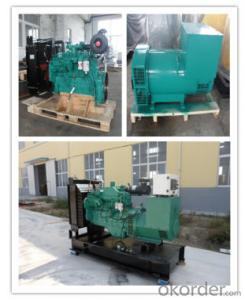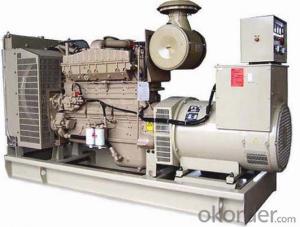Factory price china yuchai diesel generator sets 240kw
- Loading Port:
- Shanghai
- Payment Terms:
- TT OR LC
- Min Order Qty:
- 1 unit
- Supply Capability:
- 300 unit/month
OKorder Service Pledge
OKorder Financial Service
You Might Also Like
Specifications
open type dioesel generator with yuchai enginee
1) Factory direct sale
(2) CE, ISO9001 quality
Power range | 18-650KW |
Engine | All series powered by Yuchai engine |
Alternator | All series owning alternator options of Stamford/Marathon/ENGGA |
Controller system | Hanging control box, automatic control module Smartgen HGM6310 |
Base frame | International channel steel welded base, inbuilt composite damping system; sandblast, acid-washing, antiseptic treatment |
Radiator | Standard genset-joining radiator of 40 °C ambient temperature |
Diesel generator Powered by Yuchai Engine,which yuchai is a large state-owned enterprise and a Nasdaq listed company in USA (NYSE:CYD). Its main business covers diesel engine, contruction machinery, vehicle parts. The engines produced by Yuchai include series YC6G, YC4G, YC4E to which American technology applied, series YC6A, YC6B, YC6J, YC4B, YC4D, YC4F, YC4W to which German technology applied, and YC6M series in which world top technology integrated, totally 12 series.
| FKS-Y240 | 240 | 200 | YC6G245L-D20 | 6 | ≤195 | 2500*970*1500 | 2300 |
- Q: I have a 3 phase 30k 60hz generator what would I need to do to use this to power my home ?
- You need a Transfer switch, either manual $350.00 or automatic over a $1,000.00 The switch will stop the possibility of back feeding power either from the utility to the generator or from the generator to the utility.
- Q: I am wondering did water go over these reactors, and if they did is that what caused the problems, and if not, what in fact really happened?Could the devastation have been worse if water washed over it?
- The Tsunami washed INTO the Reactors. -Short circuiting the Power supply much of the Instrumentation that runs Them. And THAT's Why the Japanese are struggling with Them NOW -It's almost as if You dropped your iPod into Sea Water- and really Messed it up !! Well, Salt Water Nuclear Reactors don't mix very well- either !! :(
- Q: i am having a electrical paper in my semester. I want to know about the design of a electrical generator
- Torque is not the right question to ask in this problem! First define the generator output in terms of watts. Assume an efficiency of 0.8 for the generator and define the Input of the generator (In Out / 0.8). This is the output of your motor (assuming some diesel/petrol). Torque is expressed as N/m (force x radius) and is part of the electric generator specs. See there to get the equivalence. Usually, the motor power is also 0.8 efficient, so the motor power should be W / (0.8*0.8) and that will give you the right ratio.
- Q: I live in california, in the ventura count so anywhere close to there.
- Cities, Counties, and States each have surplus equipment sales. I have seen diesel generators in our State Surplus Yard. Another place is OKorder. How large a generator do you want? I can find one and give you the link.
- Q: I'm a student majoring in Architecture one of my class, Building Utilities, needs me to survey a high rise building. In my team, we divided the parts bc there are so many and one of my job is to electricity. Can someone explain to me the meaning of phase, R.P.M, power factor, and (especially) their respective units/numbers from this picture
- 'Phase' has no units: it is merely a number, in this case 3. It is the number of different live supplies coming out of the generator. On the blue label in your picture, to the right of the word PHASE there is a small clear panel. The 3 followed by a greek letter 'phi' is the number of phases. Then there is '4 W'. This tells you that the generator is wired in 'star' layout with a total of four wires. Three carry the live supplies and one is a neutral wire. Your building will have a lot of wall outlets and some heavy loads; for example, the motors for the elevators. The wall outlets are single phase, connected to only one of the phases from the generator. Heavy loads are often connected to all three phases. 'R.P.M'. is revolutions per minute , which means 'how many times the rotating part of the generator rotates in one minute'. 'Power factor' again has no units. An explanation of what it is? I'll come back to that later (or someone else can) .
- Q: i started work in a company and i have to maintain a fuel record of diesel generators.i need to know about this term,kindly answer me in good and easy manner and get 10 points.
- As opposed to mileage on a vehicle, the hours meter keeps record of the hours of operation, for servicing, etc.
- Q: i want to put three phase current of two diesel generating sets in only three phase.
- you will need to govern them together, other wise if one is running slightly slower than the other the slower one will act as a motor and not a generator/ alternator. so both must turn at the same rpm speed. then its just wiring configuration delta - delta or Y - Y configurations.
- Q: I figured it might be diesel generators but I wonder how all that works. I am curious person. LOL
- All ships have electric generators to supply their own current. It is separate from the main engine so while the main engine is shut down they will still have electricity.
- Q: 1. How does a generator work?2. What is the use/importance of a transformer?3. How does a capacitor work? 4. How does a rectifier work? (rectifier circuit)5. What is a p-type semi-conductor?6. What is an n-type semi-conductor?7. How does electromagnetism work in a motor?8. What are the processes in electrical energy transmission from electric power plants to consumers?I prefer simple explanations so it can be easily understood. Thanks.
- the answer is C. The reasoning in the back of it truly is, the generator is extracting means out of the circulation of the bicycle. because it rolls down the hill, your bicycle sensible factors % because means received from gravity will upload means to the bicycle. once you've a generator connected to the wheel, the means will be diverted between bicycle gaining % and shining the person-friendly bulb. Now, extra means person-friendly bulb consumes, extra means receives diverted to the generator and a lot less is on the marketplace to attain the speed. ultimately inspite of the truth that, if there's no person-friendly bulb (aka burnt), then no means receives diverted to the generator. hence, maximum means will be accessible for the bicycle. hence, it sensible factors the most % if the bulb is burnt.
- Q: Cummins diesel engine QSX15G8 timing
- ITS ESSY
Send your message to us
Factory price china yuchai diesel generator sets 240kw
- Loading Port:
- Shanghai
- Payment Terms:
- TT OR LC
- Min Order Qty:
- 1 unit
- Supply Capability:
- 300 unit/month
OKorder Service Pledge
OKorder Financial Service
Similar products
Hot products
Hot Searches
























